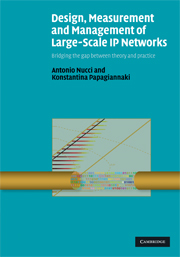 Design, Measurement and Management of Large-Scale IP Networks
Design, Measurement and Management of Large-Scale IP Networks from I - Network monitoring and management
Published online by Cambridge University Press: 05 September 2012
As networks continue to grow rapidly in size and complexity, it has become increasingly clear that their evolution is closely tied to a detailed understanding of network traffic. Large IP networks are designed with the goal of providing high availability and low delay/loss while keeping operational complexity and cost low. Meeting these goals is a highly challenging task and can only be achieved through a detailed knowledge of the network and its dynamics.
No matter how surprising this may seem, IP network management today is primarily reactive in nature and relies on trial and error when problems arise. Network operators have limited visibility into the traffic that flows on top of their network, the operational state of the network elements and the behavior of the protocols responsible for the routing of traffic and the reliable transmission of packets from end to end. Furthermore, design and planning decisions only partially rely on actual usage patterns. There are a few reasons behind such a phenomenon.
First, the designers of IP networks have traditionally attached less importance to network monitoring and resource accounting than to issues such as distributed management, robustness to failures and support for diverse services and protocols. Thus, IP network elements (routers and end hosts) have not been designed to retain detailed information about the traffic flowing through them, and IP protocols typically do not provide detailed information about the state of the underlying network.
To save this book to your Kindle, first ensure [email protected] is added to your Approved Personal Document E-mail List under your Personal Document Settings on the Manage Your Content and Devices page of your Amazon account. Then enter the ‘name’ part of your Kindle email address below. Find out more about saving to your Kindle.
Note you can select to save to either the @free.kindle.com or @kindle.com variations. ‘@free.kindle.com’ emails are free but can only be saved to your device when it is connected to wi-fi. ‘@kindle.com’ emails can be delivered even when you are not connected to wi-fi, but note that service fees apply.
Find out more about the Kindle Personal Document Service.
To save content items to your account, please confirm that you agree to abide by our usage policies. If this is the first time you use this feature, you will be asked to authorise Cambridge Core to connect with your account. Find out more about saving content to Dropbox.
To save content items to your account, please confirm that you agree to abide by our usage policies. If this is the first time you use this feature, you will be asked to authorise Cambridge Core to connect with your account. Find out more about saving content to Google Drive.